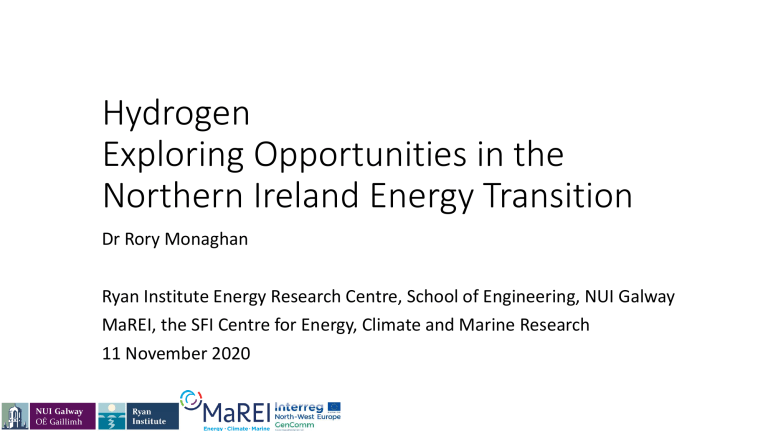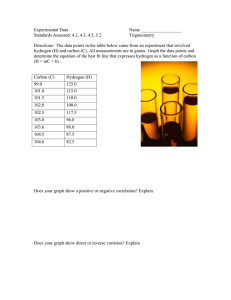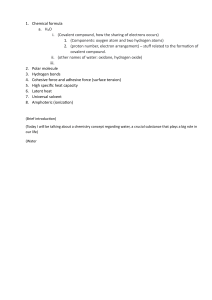
Hydrogen Exploring Opportunities in the Northern Ireland Energy Transition Dr Rory Monaghan Ryan Institute Energy Research Centre, School of Engineering, NUI Galway MaREI, the SFI Centre for Energy, Climate and Marine Research 11 November 2020 Background • NI Department for the Economy commissioned NUI Galway, with partners Dublin City University and HyEnergy Consulting, to prepare a report on the opportunities for Northern Ireland in hydrogen. • This webinar seeks input from key stakeholders for the final report. • Your further input is very welcome. Please email rory.monaghan@nuigalway.ie with the subject line “Northern Ireland Hydrogen”. 2 Overview • Key Technologies & Applications for NI • Enabling Policies in UK, ROI & EU • 2030 Hydrogen Scenarios • Outlook 3 Water Electricity Key Technologies & Applications • Production • Electrolysers • Steam Methane Reforming (with & without CCUS) Oxygen Electrolyser Production Natural gas Water Steam Methane Reformer Carbon capture Hydrogen Hydrogen • Storage & Transportation • Pressurised gas • Cryogenic liquid • Hydrogen-containing liquids • End use • Existing gas-burning appliances (boilers, engines, gas turbines) • Industrial feedstock • Fuel cells 4 CO2 Water Electricity Key Technologies & Applications Oxygen • Storage & Distribution • Pressurised gas • Cryogenic liquid • Hydrogen-containing liquids • End use Steam Methane Reformer Electrolyser Carbon capture • Production • Electrolysers • Steam Methane Reforming (with & without CCUS) Production Natural gas Water Hydrogen Hydrogen Storage & Distribution Compressor Highpress cyl Nat. gas grid Salt caverns Liquefaction Chemical transformation Cryo liq. tanks Liquid tanks • Existing gas-burning appliances (boilers, engines, gas turbines) • Industrial feedstock • Fuel cells 5 CO2 Water Electricity Key Technologies & Applications Oxygen • Storage & Distribution • Pressurised gas • Cryogenic liquid • Hydrogen-containing liquids • End use applications • Existing gas-burning appliances (boilers, engines, gas turbines) • Industrial feedstock • Fuel cells Production Steam Methane Reformer Electrolyser Carbon capture • Production • Electrolysers • Steam Methane Reforming (with & without CCUS) Natural gas Water Hydrogen Hydrogen Storage & Distribution Compressor Highpress cyl Nat. gas grid Salt caverns Liquefaction Chemical transformation Cryo liq. tanks Liquid tanks End Use Applications Transport Heating Power Blended ICEs, fuel cells Boilers, fuel cells (for CHP) Blended GTs, fuel cells Trans & Storage Longterm, highcapacity Ind. Feed. Chem, steel, others 6 CO2 Water Electricity Key Technologies & Applications Oxygen • Storage & Distribution • Pressurised gas • Cryogenic liquid • Hydrogen-containing liquids • End use applications • Existing gas-burning appliances (boilers, engines, gas turbines) • Industrial feedstock • Fuel cells Production Steam Methane Reformer Electrolyser Carbon capture • Production • Electrolysers • Steam Methane Reforming (with & without CCUS) Natural gas Water Hydrogen Hydrogen Storage & Distribution Compressor Highpress cyl Nat. gas grid Salt caverns Liquefaction Chemical transformation Cryo liq. tanks Liquid tanks End Use Applications Transport Heating Power Blended ICEs, fuel cells Boilers, fuel cells (for CHP) Blended GTs, fuel cells Trans & Storage Longterm, highcapacity Ind. Feed. Chem, steel, others 7 CO2 Electrolysers • System that splits water to hydrogen and oxygen • Input water needs to be pure but can be sourced via mains, bore holes or desalination processes • Produced hydrogen can be compressed, stored and shipped to power a variety of applications • If electricity is renewable, HYDROGEN IS GREEN Scale up • Electrolysis has been widely accepted through Europe as a leading method to fight CO2 emissions • Gigawatts (GWs) of electrolysers are being planned around the globe • UK also has large systems planned i.e. 1.8 GW for the Zero Teesside initiative Steam Methane Reforming (SMR) • SMR technology splits natural gas (NG) into mixture of hydrogen, CO and CO2 • Industries use SMR technology to deliver large quantities of H2 and CO with remaining CO2 being released to atmosphere • The process is mature with systems capable of producing up to 100s of metric tonnes per day of H2/CO • Currently over half the worlds hydrogen is derived from NG feedstocks SMR and Carbon Capture Utilisation and Storage (CCUS) • Capturing the CO2 produced by SMR can decarbonise the process • Captured CO2 can be stored in underground geological features or used • If CO2 is captured/used, HYDROGEN IS BLUE • Many large scale CCUS projects are being developed, and the UK is seeking to become world leading in CCUS technology. The Acorn Project will capture about 200,000 tonnes of CO2 from the St Fergus Gas Terminal Salt Caverns for Gas Storage • Used to store gases including hydrogen since the 1950s • Sites have traditionally been developed after salt extraction by the chlorine industry • Over 30 caverns in use in the UK today • mainly used for NG • 1 in use for hydrogen • internal wall properties prevent leakage and contamination of the hydrogen • Lowest cost direct storage mechanism for large hydrogen volumes • Possibility to use Larne salt caverns for hydrogen storage Renewable Hydrogen in Mobility & Transport Application Status/Examples Cars & vans 11,000+ vehicles in California, Japan, Short refuelling time Europe High energy density (v Li-ion) Long range (v Li-ion) Early commercial technologies 25,000 forklifts, 900 buses & trucks, Zero tailpipe emissions Low material footprint including Aberdeen, Belfast & Trucks & buses Advantages Disadvantages Low network efficiency H2: Chicken and egg P2L: High cost NH3: Hazardous Dublin Rail Trains in Germany, UK, Austria & Netherlands Low cost zero emissions for low utilisation lines Many lines already electrified Maritime Small demonstration projects H2 & NH3: Zero exhaust emissions Very few other options Low energy density (v liquids) Aviation Small demonstration projects P2L: High energy density Long range High value use for biomass P2L: High cost H2: Fuel tank & airframe redesign 12 EU Position on Hydrogen European Commission “A Hydrogen Strategy for a Climate-Neutral Europe”, 2020. https://ec.europa.eu/energy/sites/ener/files/hydrogen_strategy.pdf 13 Policy – UK and EU • 2020 has seen release of Hydrogen policies and roadmaps in France, Germany, Netherlands & Portugal • UK and Ireland (due 2021) are lagging behind which has a knock-on effect on Northern Ireland • How will Northern Ireland’s policy be shaped by the regions surrounding them? • EU and other regions primary targets: • UK government primary targets: • • • • • Reduction in carbon emissions Hydrogen Mobility Utilising and promoting the use of British solutions Job creation and skills development Green hydrogen with substantial blue hydrogen use Market Development 2020 • • • • • Reduction in carbon emissions Hydrogen Mobility Energy Diversity and Security Foster regional economic growth Green hydrogen almost exclusively, with other technologies to help transition Rapid Market Delivery/Uptake 2030 Market Rationalisation 2040 2050 14 All-Island Potential • Both Ireland and Northern Ireland have enormous untapped renewable energy resources • Modern, increasingly interconnected electricity grid can accommodate high RES-E & SNSP • The modern, shared interconnected gas grid can be primed for hydrogen injection at a relatively low cost • Reduce reliance on imported fuels and help bring household expenditure on energy down (NI has highest UK regional cost) • Shared codes and standards • Shared storage systems • Shared mobility infrastructure projects? • Hydrogen refuelling stations both sides of the border • Enables island-wide transportation corridors • Renewal of rail rolling stock with H2 trains 15 2030 Hydrogen Scenarios Scenario 1: distributed H2 electrolysis, transport to nearest bus network or grid injection point 16 2030 Hydrogen Scenarios Scenario 1: distributed H2 electrolysis, transport to nearest bus network or grid injection point Scenario 2: Regional H2 electrolysis in Northwest, followed by: • 2a: Transport to Derry/Londonderry to fuel 90 buses & 150 trucks • 2b: Injection to natural gas grid to meet 10% of regional demand 17 2030 Hydrogen Scenarios Scenario 1: distributed H2 electrolysis, transport to nearest bus network or grid injection point Scenario 2: Regional H2 electrolysis in Northwest, followed by: • 2a: Transport to Derry/Londonderry to fuel 90 buses & 150 trucks • 2b: Injection to natural gas grid to meet 10% of regional demand Scenario 3: Centralised H2 production near Belfast, followed by: • 3a: Transport to Belfast to fuel 210 buses & 350 trucks • 3b: Injection to natural gas grid to meet 10% of Greater Belfast demand 18 Estimating Hydrogen Demand Transport Sector Number of FCEV urban buses 1000 800 600 400 200 • Projections based on fleet turnovers, diesel bans, EU & HMI figures • Projected number of FCEV urban buses in NI Low Medium High • 70:30 split between Belfast & Derry • 50,000 km per year 0 2021 2022 2023 2024 2025 2026 2027 2028 2029 2030 Number of FCEV 40-tonne trucks 1000 800 600 400 Low Medium High 200 • Projected number of FCEV 40-tonne trucks in NI • 70:30 split between Belfast & Derry areas • 100,000 km per year 0 2021 2022 2023 2024 2025 2026 2027 2028 2029 2030 19 Estimating Hydrogen Demand Transport Sector Number of FCEV urban buses 1000 800 600 400 200 • Projections based on fleet turnovers, diesel bans, EU & HMI figures • Projected number of FCEV urban buses in NI Low Medium High • 70:30 split between Belfast & Derry • 50,000 km per year Natural Gas Use • 10% of 2019 gas consumption in Derry-Strabane and Causeway Coast & Glens (Scenario 2) • 10% of 2019 gas consumption in Greater Belfast (Scenario 3) 0 2021 2022 2023 2024 2025 2026 2027 2028 2029 2030 Number of FCEV 40-tonne trucks 1000 800 600 400 Low Medium High 200 • Projected number of FCEV 40-tonne trucks in NI • 70:30 split between Belfast & Derry areas • 100,000 km per year 0 2021 2022 2023 2024 2025 2026 2027 2028 2029 2030 20 Annual hydrogen demand? Production location? Production capacity? Demand location? Deman d Supply Centralised/ decentralised? • For each scenario, we calculate capital & operating costs for hydrogen production, storage & transportation in the value chain. • Cost projections to 2030, transportation distances & economies of scale are included. • This gives a levelised cost per kg of delivered hydrogen for each scenario Applications and endusers? Developing a Hydrogen Value Chain Capacity? Transport Gas grid Location? Renewable sources? Industry 2030 Hydrogen Scenarios - Results Scenario Value Chain Type 1 2a 2b 3a 3b Location Electricity Source Demand Type Optimum Production Transport CO2 Savings Electrolyser Cost per kg H2 Cost per kg H2 Capacity Distributed Throughout NI Wind Farms Various 350 kW – £2.30 - £12 £0.45 - £2.25 n/a 3.5 MW Regional Derry Grid 90 buses, 150 10 MW £2.70 - £4.50 £0.40 4,400 tCO2 trucks Regional Northwest Grid 10% NW NG 14 MW £2.60 - £4.40 £0.00 2,800 tCO2 Demand Centralised Belfast Grid 210 buses, 350 23 MW £2.50 - £4.40 £0.10 10,300 tCO2 trucks Centralised Greater Belfast Grid 10% Greater 94 MW £2.40 - £4.20 £0.00 18,500 tCO2 Belfast NG Demand 22 2030 Hydrogen Scenarios - Context Transport scenarios • Scale & location are crucial to reduce production and transportation costs • Minimum delivered cost = £2.60/kg for Belfast • Equivalent to 72p per litre of diesel • Bans on diesel-only buses in place in UK & ROI • RTFO could subsidise hydrogen production ~£5/kg if • Electrolyser is connected directly to RES-E • RES-E is purpose-built for hydrogen production • World’s first double-decker hydrogen fuel cell bus is designed and built in Northern Ireland • Hyundai Xcient hydrogen fuel cell 40-tonne truck has entered the European market (Switzerland) 23 2030 Hydrogen Scenarios - Context Gas grid scenarios • Scale & location are crucial to reduce production and transportation costs • Minimum delivered cost = £2.40/kg for Belfast • Equivalent to 7.2p/kWh • Median NI domestic gas customer paid 4.8 p/kWh in H1 2019 • Modern and growing gas grid in NI and ROI presents opportunities • Grid injection underway in GB (HyDeploy) and ROI (GNI blending site in Brownsbarn, Dublin) • Options for further in the future • Blending at gas-fired power plants • Storage in Larne salt cavern 24 GenComm Ireland’s First Green Hydrogen Supply Chain 27-MW Long Mountain Wind Farm, Co Antrim 3x Bamford Fuel Cell double-decker buses 2x 250-bar tube trailers 500-kW Areva electrolyser Bus fuelling depot, Belfast 25 Offset fossil fuel usage with H2 EMISSION REDUCTIONS New H2 applications to replace carbonemitting processes Reduce reliance on imported carbon fuels ENERGY DIVERSITY Focus on hydrogen for heat and goods across Ireland Skilled Job Creation – Manufacturing and O&M ECONOMIC BENEFITS Potential Hydrogen Export to UK/ROI/EU Drivers Outlook WHAT DOES THIS MEAN FOR NORTHERN IRELAND? RES EXPANSION H2 TECH TESTING GROUND NORTHERN IRISH EXPERTISE Utilise large renewables potential Large green H2 Potential Prove viability of UK technology Ireland-wide gas grid injection Historic manufacturing and fabrication Operational skills, expertise and added value Opportunities 26 Acknowledgements • Cian Moran & Arya Gunawan at NUI Galway • Jochelle Laguipo & Dr James Carton at Dublin City University • Josh Williamson, Tim Williamson, Diana Raine & Ian Williamson at HyEnergy Consulting • Paul McCormack at Belfast Metropolitan College • Meabh Cormacain & Eddie Kerr at the Department for the Economy Your further input is very welcome. Please email rory.monaghan@nuigalway.ie with the subject line “Northern Ireland Hydrogen”. 27


